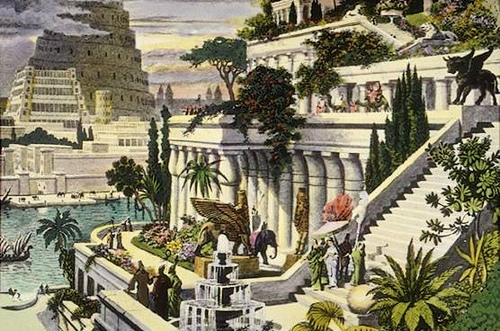
Ten Random Facts’ birthday!
The legend of the Hanging Gardens of Babylon.
- The Hanging Gardens of Babylon is a legendary, and possibly mythical, garden part of the Seven Wonders of the Ancient World.
- The Hanging Gardens of Babylon are said to have had large pillars and a number of tiers and terraced levels, and the translation from the Greek and Latin words to describe the garden, more accurately use the word ‘overhanging’ rather than the literally ‘hanging’ garden which is depicted in the garden’s name.
- The Hanging Gardens of Babylon is the only Wonder of the Ancient World that does not have a proven location.
- According to Greek texts, the Hanging Gardens of Babylon is depicted as a lush garden of exotic foliage and wildlife, with man-made waterfalls.
- It has been historically believed that the Hanging Gardens of Babylon were located at the ancient city of Babylon, built by King Nebuchadnezzar II, although there is no Babylonian evidence.
 By Maarten van Heemskerck, 16th century engraving
By Maarten van Heemskerck, 16th century engraving
Image courtesy of Carla216/Flickr
- There are many theories of the location of the Hanging Gardens of Babylon, with a lot of evidence supporting the ‘Hanging Gardens of Nineveh’ theory, and if this is true, the gardens would have been owned by King Sennacherib.
- Some believe that the Hanging Gardens of Babylon were destroyed in an earthquake, although many others believe erosion and conquest were the destruction factors.
- It is believed that the Hanging Gardens of Babylon were built in the 6th or 7th century BC.
- Historians believe that walls of the Hanging Gardens of Babylon were 24 metres (80 feet) in height, approximately the height of five storey building, and were made from a type of brick.
- The height of the Hanging Gardens of Babylon would have required a significant irrigation system, that has been described as an amazing engineering feat.
Bibliography:
12 Key Facts and Legends about the Hanging Gardens of Babylon, 2010, Ancient World Wonders, <http://ancientworldwonders.com/12-facts-about-the-hanging-gardens-of-babylon.html>
Kyrstek L, The Hanging Gardens of Babylon, 2010, Seven Wonders of the Ancient World, <http://www.unmuseum.org/hangg.htm>






